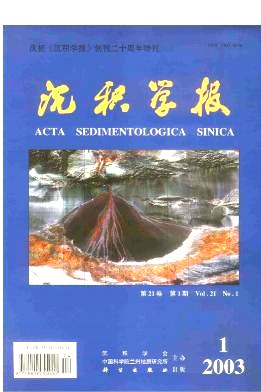HTML
| [1] | [1]Rolland Y, Pecher A, Picard C. Middle Cretaceous back-arc forma tion and arc evolution along the Asian margin: the Shyok Suture zone in northern Ladakh (NW Himalaya)[J]. Tectonophysics, 2000, 325: 145~173 [2]Treloar P J, Petterson M G, Jan M Q, et al. A re-evaluation of the stratigraphy and evolution of the Kohistan Arc sequence, Pakistan Himalaya: imp lications for magmatic and tectonic arc-building processes[J]. Journal of th e Geoloical Society, London, 1996, 153: 681~693 [3]徐仁. 青藏高原植被的变化和高原的隆升[J]. 青藏高原生态和地质研究,1981 ,1:139~144[Xu R. Vegetational changes in the past and uplift of the Qinghai-X izang plateau[J]. Geological and Ecological Studies on the Qinghai-Xizang Pla teau, 1981, 1:139~144] [4]Allegre C J, Courtillot V, Tapponnier P, et al. Structure and evolu tion of the Himalaya-Tibet orogenic belt[J]. Nature, 1984, 307: 17~22 [5]Chang C F, Chen N, Coward M P, et al. Preliminary conclusions of th e Royal Society/Academia Sinica 1985 Geotraverse of Tibet[J]. Nature, 1986, 32 3: 501~507 [6]Dewey J F, Shackleton R M, Chang C F, et al. The tectonic developme nt of the Tibetan plateau[J]. Philosophical Transactions of the Royal Society, London A, 1988, 327: 379~413 [7]萧序常,李廷栋,李光岑等. 喜马拉雅岩石圈构造演化[M]. 北京: 地质出版社 ,1988. 1~188[Xiao X C, Li T D, Li G C, et al. Tectonic evolution of the Hi malayan lithosphere[M]. Beijing: Geological Publishing House, 1988. 1~188] [8]余光明,王成善. 西藏特提斯沉积地质[M]. 北京: 地质出版社, 1990. 1~185 [Yu G M, Wang C S. Sedimentary Geology of the Xizang (Tibet) Tethys[M]. Beiji ng: Geological Publishing House, 1990. 1~185] [9]钟大赉,丁林. 青藏高原的构造发展[J]. 中国科学(D), 1996, 26: 289~295[ Zhong D L, Ding L. Tectonic development of the Tibetan plateau[J]. Science in China (D), 1996, 26: 289~295] [10]潘桂棠,陈智梁,李兴振等. 东特提斯地质构造形成演化[M]. 北京: 地质出版社,1 997. 1~218[Pan G T, Chen Z L, Li X Z, et al. Geologic and tectonic formati on and evolution of the eastern Tethys[M]. Beijing: Geological Publishing Hous e, 1997. 1~218] [11]England P, Searle M. The Cretaceous-Tertiary deformation of the Lhasa terra in and its implications for crustal thickening in Tibet [J]. Tectonics, 1986, 5: 1~14 [12]Mattauer M. Intracontinental subduction, crust-mantle decollement and crust al-stacking wedge in the Himalayas and other collision belts[J]. Geological S ociety Special Publications, 1986, 19: 37~50 [13]Murphy M A, Yin A, Harrison T M, et al. Did the Indo-Asian collision al one create the Tibetan plateau?[J]. Geology, 1997, 25: 719~722 [14]刘训,傅德荣,姚培毅等.青藏高原不同地体的地层、生物区系及沉积构造演化史[M] . 北京: 地质出版社, 1992. 1~168[Liu X, Fu D R, Yao P Y, et al. Stratigraphy , paleogeography, and sedimentary-tectonic development of Qinghai-Xizang plateau [M]. Beijing: Geological Publishing House, 1992. 1~168 [15]西藏地质矿产局. 西藏自治区地质志[M]. 北京: 地质出版社, 1993. 1~707[Xizang Bureau of Geology and Mineral Resources. Regional Geology of Xizang Autonomous Region, China[M]. Beijing: Geological Publishing House, 1993. 1~707 [16]Zhang K J, Xia B D, Liang X W. Mesozoic and Paleogene sedimentary facies and paleogeography of Tibet: tectonic implications[J]. Geological Journal, 2002, 37: 217~246 [17]Yin J, Xu J, Liu C, et al. The Tibetan plateau: Regional stratigraphic c ontext and previous work[J]. Philosophical Transactions of the Royal Society , London A, 1988, 327: 5~52 [18]林宝玉,王乃文,王思恩等. 西藏地层[M]. 北京: 地质出版社,1989. 1~168[Lin B Y, Wang N W, Wang S, et al. Stratigraphy of Xizang Province, China[M]. Beijing: Geological Publishing House, 1989. 1~168] [19]Zhang K J. Cretaceous paleogeography of Tibet and adjacent areas (China): te ctonic implications[J]. Cretaceous Research, 2000, 21: 23~33 [20]郭铁鹰,梁定益,张宜智等. 阿里地质[M]. 武汉: 中国地质大学出版社,1991. 1~4 64[Guo T Y, Liang D Y, Zhang Y Z, et al. Geology of Ngari, Tibet (Xizang), China[M]. Wuhan: The China University of Geosciences Press, 1991. 1~464] [21]杨式溥,宋志敏,梁定益. 西藏阿里(狮泉河-多玛)地区中侏罗世-早白垩世复理石相遗迹化石[J]. 地质学报,1982, 56: 302~313[Yang S P, Song Z M, Liang D Y. Middle Jurassic to Early Cretaceous flysch trace fossils from Ngari region, Tibet (Chin a)[J]. Acta Geologica Sinica, 1982, 56: 302~313] [22]Zhang K J, Zhang Y J, Xia B D. Did the Indo-Asian collision alone create th e Tibetan plateau? -Comment[J]. Geology, 1998, 26: 1098~1099 [23]Garzanti E, Vezzoli G, Ando S, et al. Petrology of rifted-margin sand ( Red Sea and Gulf of Aden, Yemen)[J]. The Journal of Geology, 2001, 109: 277~2 97 [24]Ori G G, Friend P F. Sedimentary basins formed and carried piggyback on acti ve thrust sheets[J]. Geology, 1984, 12: 475~478 [25]Wilson J L. Carbonate facies in geologic history[M]. Berlin: Springer-Ver lag, 1975. 1~471 [26]唐天福,薛耀松,俞从流. 新疆塔里木盆地西部晚白垩世至早第三纪海相沉积特征及沉积环境[M]. 北京: 科学出版社,1992. 1~138[Tang T F, Xue Y S, Yu C L. Character istics and sedimentary environments of the Late Cretaceous to early Tertiary mar ine strata in the western Tarim basin, China[M]. Beijing: Science Press, 1992. 1~138] [27]成都地质矿产研究所,四川区调队. 怒江、澜沧江、金沙江区域地层[M]. 北京: 地质出版社,1992. 1~469[Chengdu Institute of Geology and Mineral Resources, Sich uan Geological Survey. Stratigraphy in the Nujiang-Lancangjiang-Jinsajiang re gion[M]. Beijing: Geological Publishing House, 1992. 1~469] [28]Xu R H, Scharer U, Allegre C J. Magmatism and metamorphism in the Lhasa bloc k (Tibet): a geochronological study[J]. Journal of Geology, 1985, 93: 41~57 [29]Debon F, Le Fort P, Sheppard S M F, et al. The four plutonic belts of th e Transhimalaya-Himalaya: A chemical, mineralogical, isotopical and chronologic al synthesis along a Tibet-Nepal section[J]. Journal of Petrology, 1986, 27: 219~250 [30]王希斌,鲍佩声,邓万明等. 西藏蛇绿岩[M]. 北京: 地质出版社, 1987. 1~336[Wa ng X B, Bao P S, Deng W M, et al. Ophiolites of Xizang[M]. Beijing: Geolog ical Publishing House, 1987. 1~336] [31]Hsu K J, Pan G T, Seng Φr A M C. Tectonic evolution of the Tibetan Plateau: A working hypothesis based on the archipelago model of orogenesis[J]. Interna tional Geology Review, 1995, 37: 473~508 |






 DownLoad:
DownLoad: